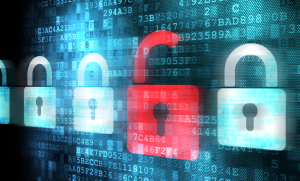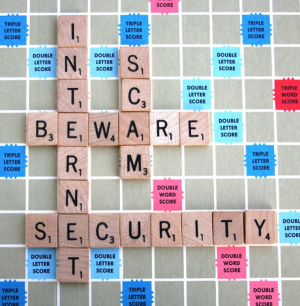Difference between revisions of "Cybersecurity"
(→Cybersecurity Threats & Our Plural Selves) |
(→The Future of Cybersecurity) |
||
| Line 47: | Line 47: | ||
== The Future of Cybersecurity == | == The Future of Cybersecurity == | ||
| − | + | As technology is evolving, security threats increases and limits one's safety. Cybersecurity will continue to become more and more important in the near future as daily tasks are online. According to research released by the International Data Corporation, businesses are expected to spend $101.6 billion dollars in 2020 on cybersecurity software, services, and hardware. This number will most likely increase as time goes by. There is nothing we can do to stop the advancement of cyberattacks. We will always want to protect our identities or the identities we’ve chosen to share with the world. If we could continue to take the necessary steps to protect ourselves online is it possible that execute this through the proper channels. | |
== <small><small><small></small> References == | == <small><small><small></small> References == | ||
Revision as of 21:00, 10 April 2019
Cybersecurity is the practice of protecting systems, networks, and programs from cyberattacks. Cyberattacks are malicious attempts by an individual or a group to hack the online information system of another individual or group. These cyberattacks are usually aimed at retrieving personal information in order to access, change, or destroy it typically in an effort to extort money or information.[1] In the digital world, many transactions are made online involving confidential information and money. The purpose of cybersecurity is to protect endpoint devices like computers, smart devices, and routers; networks; and the cloud from these breaches. Without cybersecurity in such a tech-connected world, cyberattacks can yield negative repercussions for those who are targeted and involved. These consequences may include but are not limited to identity theft, extortion, and loss of sentimental digital memories like family photos and videos.
Contents
Types of Cyberattacks
Typically, cyberattackers are seeking a ransom or participating in “hacktivism,” which is defined as hacking as a form of political or social expression. They may use a variety of tools to launch attacks, including malware, ransomware, exploit kits, and etc. Below are some of the most common types of cyberattacks used today:
- Denial-of-Service: With denial-of-service attacks, hackers send a rush of attacks to overwhelm systems, servers, or networks to overwork bandwidth and resources. Some hackers take over more than one device to organize a denial-of-service attack.
- Malware: Examples of malware include software, spyware, viruses, bugs, worms, and ransomware. Malware is often able to permeate a network through links or email attachments that sometimes install dangerous software without the user’s knowledge. Malware can block access to the network, install additional software, transfer and send out secure data from the hard drive, and fry the system.
- Man-in-the-Middle (MitM): These cyberattacks are categorized by a hacker sneaking into seemingly-two-party transactions. They’re essentially eavesdropping in an effort to steal information. Common points of entry for these types of cyberattacks are public Wi-Fi networks that are not secure, and after malware has gotten into a network.
- Phishing: Phishing usually happens through email when a hacker sends a fraudulent message that seems to be from a legitimate source but is not. Usually, the goal is to get credit card information or website login credentials or to have them open a file or link that will install malware on their computer.
- Doxing: When a user researches or obtains someone's private information and posts it publicly online. Information can be harvested using malware, publicly available social media, or online metedata such as an IP address.
- Zero-Day Exploit: When a network’s vulnerability is announced, hackers using this method launch an attack before the owner of the network has the chance to create a solution or fix whatever created the vulnerability.
Large-Scale Cyberattacks
Cyberterrorism
According to Palo Alto Networks, an American multinational cybersecurity company, cyberattacks are often directed at secret, political, military or infrastructural assets or people. Cyberattacks used by terrorist groups to further advance their agendas, whether it's political or ideological. This is simply known as cyberterrorism. Military Times reported a case on cyberterrorism in 2016 involving a 20-year-old hacker from Kosovo who pleaded guilty after hacking into a U.S. company's networks and providing Islamic terrorist group ISIS, with personal information of government employees and active military personnel. The hacker had access to retrieve their names, addresses, and financial information.
Cyberwarfare
Cyberwarfare is described by Palo Alto Networks as, nations using information technology to infiltrate the networks of other nations in an attempt to cause damage or disruption. Usually, the goal of cyberwarfare hackers is to steal valuable information, attack particular networks, or damage systems for infrastructural, transportation, medical, or commerce services. An example of a cyberwarfare attack cited by Mohan B. Gazula in his report Cyber Warfare Conflict Analysis and Case Studies, was the WannaCry ransomware attack that infected over 230,000 computers, some of which belonged to Britain’s National Health Service.
Cyberespionage
Cyberespionage refers to hacking into systems to obtain confidential information from others that they do not have the right to access. Palo Alto Networks explains it is most commonly used to, “gain strategic, economic, political or military advantage, and is conducted using cracking techniques and malware.” One case of cyberespionage was in Ukrainian Artillery Tracking. Gazula stated that a hacking group thought to be linked to the Russian government was blamed for the placement of a malware insert used to track artillery units in Ukraine. The inserts were able to recover intelligence that would have been used to attack Russian separatists.
Ethics of Cybersecurity
Self-Exposure & Exposure of the Self
Cyberattacks are constantly becoming more and more sophisticated leading to an increased need in the field of cybersecurity. As explained by Wikipedia, the field of cybersecurity is becoming increasingly important because of our increasing reliance on computer systems. These include but are not limited to smart devices and other devices that constitute the Internet of Things.
Cybersecurity is necessary as cyberattacks threaten the safety, sanctity, and identities. Interestingly, we are almost always surprised when people has the ability to find private, prevalent information about us.However, this information is commonly targeted in cyberattacks. According to David Shoemaker, author of Self-exposure and the exposure of the self: Informational privacy and the presentation of identity, “Several have tried to make the case that a threat to informational privacy is a threat to our personal identity.” A threat to our informational privacy and personal identity undermine our authority to decide on what we want our public presentations of ourselves to be. This is summarized by The Control Theory of Privacy which states that, the domain of informational privacy, the zone to be protected is information about one’s self-identity, i.e. information about all or part of the set of properties about which one’s beliefs ground emotions of self-esteem. One has the informational privacy to the extent one has control over others’ access to, and one’s own presentation of, such (unrevealed) information.
Cybersecurity Threats & Our Plural Selves
Cybersecurity serves an important role in the stability and protection of the plural selves we’ve worked so hard to develop. Dean Cocking describes our identities as a “bundle of plural selves.” He suggest we have a multitude of aspects of selves, and the way we choose to represent ourselves changes depending on the context. We understand that certain aspects of ourselves are best summoned in certain situations and with certain people, and we tend to use that information to our advantage. However, a breach of cybersecurity puts our plural selves at risk of them being discovered by those we do not wish to expose them to. That, in turn, could jeopardize the basis and foundation of the relationships we’ve achieved in particular circles, as relationships are based on an assumed mutual level of trust.
The Future of Cybersecurity
As technology is evolving, security threats increases and limits one's safety. Cybersecurity will continue to become more and more important in the near future as daily tasks are online. According to research released by the International Data Corporation, businesses are expected to spend $101.6 billion dollars in 2020 on cybersecurity software, services, and hardware. This number will most likely increase as time goes by. There is nothing we can do to stop the advancement of cyberattacks. We will always want to protect our identities or the identities we’ve chosen to share with the world. If we could continue to take the necessary steps to protect ourselves online is it possible that execute this through the proper channels.
References
1. Boyd, A. (2017, August 08). Hacker pleads guilty in first case of cyber terrorism. Retrieved February 27, 2019, from https://www.militarytimes.com/2016/06/15/hacker-pleads-guilty-in-first-case-of-cyber-terrorism/
4. Cocking, D. (2008). Plural Selves and Relational Identity(Rep.). Cambridge, U.K.: Cambridge University Press.
5. Computer security. (2019, February 27). Retrieved February 27, 2019, from https://en.wikipedia.org/wiki/Computer_security The field is growing in importance due to increasing reliance on computer systems, the Internet[2] and wireless networks such as Bluetooth and Wi-Fi, and due to the growth of "smart" devices, including smartphones, televisions and the various tiny devices that constitute the Internet of things. Due to its complexity, both in terms of politics and technology, it is also one of the major challenges of the contemporary world.
6. Cyber Attack - What Are Common Cyberthreats? (2019, February 25). Retrieved February 26, 1999, from https://www.cisco.com/c/en/us/products/security/common-cyberattacks.html
7. Cybersecurity. (n.d.). Retrieved March 1, 2019, from https://www.wmep.org/services/cybersecurity/
8. Computer security. (2019, March 22). Retrieved March 25, 2019, from https://en.wikipedia.org/wiki/Computer_security The field is growing in importance due to increasing reliance on computer systems, the Internet[2] and wireless networks such as Bluetooth and Wi-Fi, and due to the growth of "smart" devices, including smartphones, televisions and the various tiny devices that constitute the Internet of things. Due to its complexity, both in terms of politics and technology, it is also one of the major challenges of the contemporary
9. First Person Plural. (2015, August 04). Retrieved March 1, 2019, from http://www.fiftybits.com/20081113first-person-plural/
10. Gazula, M. B. (2017, May). Cyber Warfare Conflict Analysis and Case Studies. Retrieved February 27, 2019, from https://cams.mit.edu/wp-content/uploads/2017-10.pdf
11. Internet of things. (2019, March 23). Retrieved March 25, 2019, from https://en.wikipedia.org/wiki/Internet_of_things The Internet of things (IoT) is the extension of Internet connectivity into physical devices and everyday objects. Embedded with electronics, Internet connectivity, and other forms of hardware (such as sensors), these devices can communicate and interact with others over the Internet, and they can be remotely monitored and controlled.
12. Palo Alto Networks. WHAT IS CYBERSECURITY? (2019). Retrieved February 27, 2019, from https://www.paloaltonetworks.com/cyberpedia/what-is-cyber-security
13. Shoemaker, D. W. (2009). Self-exposure and the exposure of the self: Informational privacy and the presentation of identity (Rep.). Berlin, Germany: Springer Science Business. doi:10.1007/s10676-009-9186-x
14. Vanian, J. (2016, October 12). Here's How Much Businesses Worldwide Will Spend on Cybersecurity by 2020. Retrieved March 1, 2019, from http://fortune.com/2016/10/12/cybersecurity-global-spending/
- ↑ C. (2019, January 16). What Is Cybersecurity? Retrieved February 26, 2019, from https://www.cisco.com/c/en/us/products/security/what-is-cybersecurity.html


